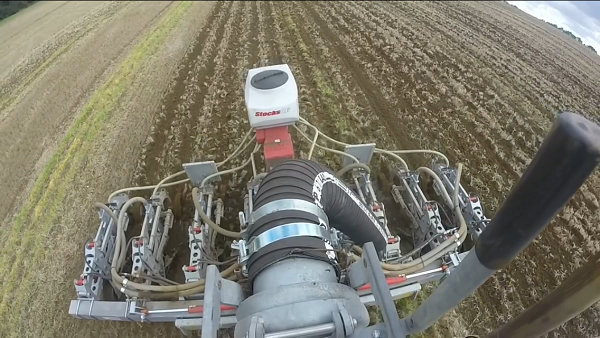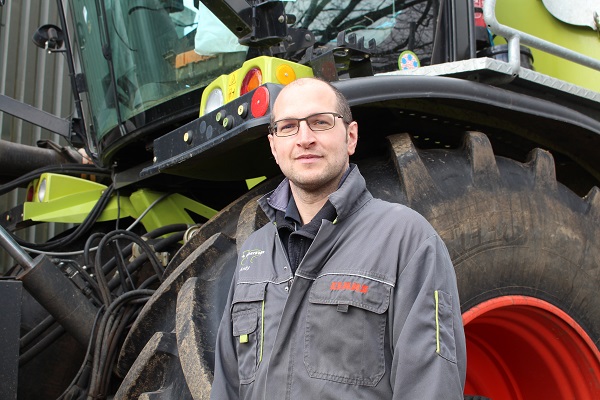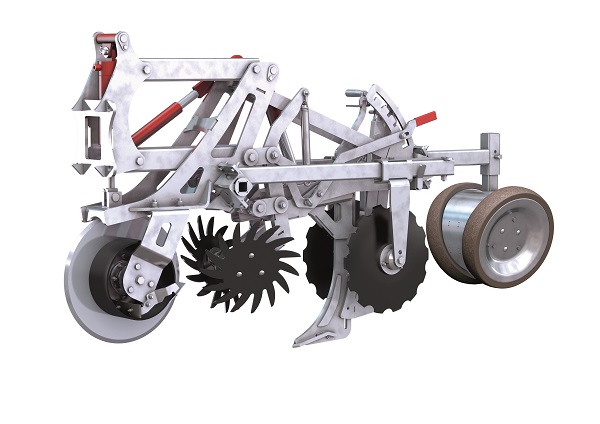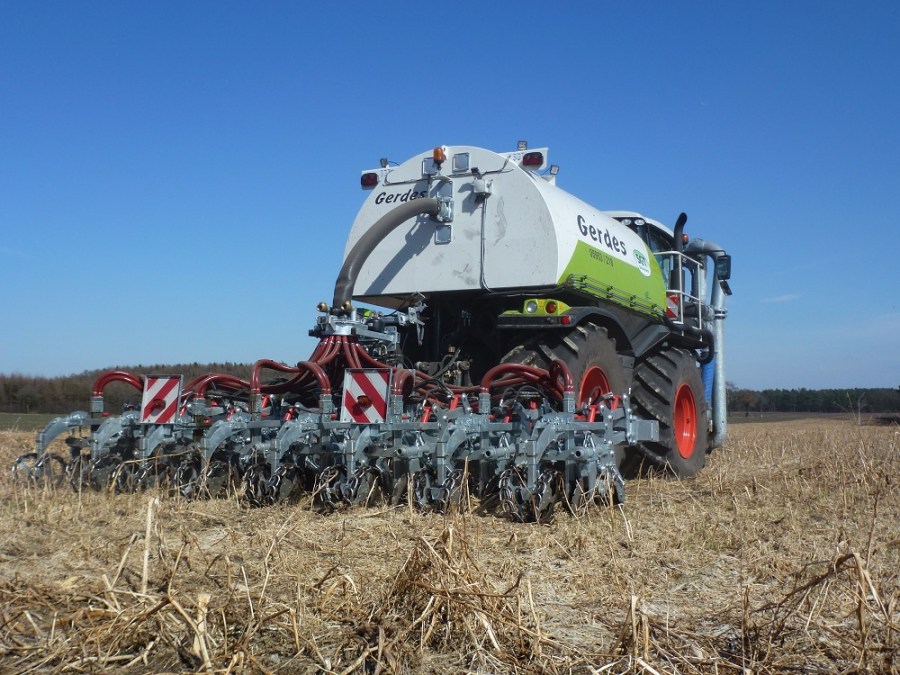The number of biogas units around the UK is rising steadily, and so too is the amount of digestate that needs an outlet. CPM investigates how it can be used to good affect by arable farmers.
During the 2015 harvest, the small amount of OSR drilled by the XTill resulted in our best OSR crop.
By Emily Padfield
What nature gives with one hand it can often take away with the other. This is never more pertinent than with farming – you get a good spring followed by a terrible summer, or a wet autumn followed by a dry winter.
And this can be said it seems for the use of digestate. It brings with it huge nutrient benefits and soil structure improvements, but on the other hand poses risks from excessive travel due to the sheer volumes of liquid involved.
For Northants agricultural contractors Pete and Richard Burbage, the decision to purchase a self-propelled tanker was driven by the growing demand from their customers for accurate and timely application of liquid manure and digestate.
The business already handled large amounts of slurry and manures anyway, both using umbilical and tanker methods, so it wasn’t digestate alone that clinched the deal, explains the tanker’s main operator Andy Russell, who adds that slurry is also dealt with in the same way.
Umbilical systems can handle pumping slurry to around 2km where it’s spread using either a 24m splash-plate or 12m dribble bar. “We can apply to both arable and grassland in this manner, and as such it’s preferable for mixed farms as there’s very little field traffic.”
Flow metres are used to record exact applications per field and all nutrient information is then provided for farm records.
Because of the limitations umbilical systems pose to many farmers, the addition of the self-propelled tanker to its tractor-drawn fleet has been a welcome one. Already commonplace in Europe, self-propelled tanker systems are getting more popular in the UK, but they’re a big investment for contractors.
The Burbages opted for a Claas Xerion with mounted 15cu m SGT tank complete with 24m dribble bar. The Xerion

The Xerion takes about 3 minutes to suck a load from another tanker and spreads in the region of seven loads an hour.
and SGT is fed by tractor-drawn Major tankers, each with the 15cu m capacity to match the Xerion and SGT.
“Depending on field conditions, these tankers may travel to the Xerion in the field for refilling using tramlines. Alternatively, they often stay out of the field and the filling arm on the SGT can be used to load the tanker in a gateway or even over a hedge.”

The decision to purchase a self-propelled tanker was driven by the growing demand for accurate and timely application of liquid manure and digestate, says Andy Russell.
Typically, the SGT is coupled to the 24m Vogelsang dribble bar, which can apply in excess of 1000cu m a day. “We apply to standing crops, but unlike the umbilical system, there’s no damage to juvenile crops, especially oilseed rape. The XTill allows slurry applications at sowing so we don’t need to access the field post drilling where field conditions may have deteriorated.
“All slurry and digestates need analysis so farmers know what they are applying to their crops, this is key,” says Andy Russell.
Seeding damage
Umbilical spreading on young OSR seedlings may cause damage as the pipe is dragged over them and it’s not always possible to limit travel to tramlines, he explains. “This is the benefit of the Xerion as it can stay on tramlines all day long. Taps on the dribble bar ensure no slurry is applied on the wheelings, either.”
And to an extent, that’s where the Vogelsang XTill comes in. Fitted with a Stocks seeder unit, it can be used to either strip-till on its own, mounted on the three-point linkage, or more usually it’s fitted to the tanker. Here, liquid slurry or digestate can be applied and oilseed rape can be broadcast in the 3inch bands it cultivates.
XTill manufacturer Vogelsang is better known for its pumping systems rather than tillage machinery. It’s already a known name for dribble bars and pumps for slurry systems as well as for AD plants.
The company’s decision to make such a jump into cultivator manufacturer came when it saw a gap in the market for strip-till machines that could also inject slurry at the same time.
The concept behind the XTill is that of strip-tillage prior to drilling, either with root-level liquid manure fertilisation or without, depending on the application and preference, explains Vogelsang’s UK sales manager Sion Williams. “With strip-till, the optimal root zone is created by loosening the soil in strips, without cultivating the whole field and without having to remove stubble and/or trash.”
The Vogelsang XTill is also offered as the XTill-VT by fellow German company Amazone but is also engineered by Vogelsang. It’s now available in a VarioCrop model, where row spacings can be quickly adjusted from 75cm to 45cm, making it more attractive to a wider audience.
And to an extent, that’s where the Vogelsang XTill comes in. Fitted with a Stocks seeder unit, it can be used to either strip-till on its own, mounted on the three-point linkage, or more usually it’s fitted to the tanker. Here, liquid slurry or digestate can be applied and oilseed rape can be broadcast in the 3inch bands it cultivates.
XTill manufacturer Vogelsang is better known for its pumping systems rather than tillage machinery. It’s already a known name for dribble bars and pumps for slurry systems as well as for AD plants.
The company’s decision to make such a jump into cultivator manufacturer came when it saw a gap in the market for strip-till machines that could also inject slurry at the same time.
The concept behind the XTill is that of strip-tillage prior to drilling, either with root-level liquid manure fertilisation or

Each coulter unit is mounted on a parallelogram and is independently depth adjustable with the pressure application infinitely variable.
without, depending on the application and preference, explains Vogelsang’s UK sales manager Sion Williams. “With strip-till, the optimal root zone is created by loosening the soil in strips, without cultivating the whole field and without having to remove stubble and/or trash.”
The Vogelsang XTill is also offered as the XTill-VT by fellow German company Amazone but is also engineered by Vogelsang. It’s now available in a VarioCrop model, where row spacings can be quickly adjusted from 75cm to 45cm, making it more attractive to a wider audience.
Clay content
For those with soils with clay content over 10%, the XTill should be used in the autumn in order to utilise the frost action, but for all other soil types, strip-tillage with the XTill is possible in the spring. “Under no circumstances should you cultivate the soil beforehand – this completely defeats the object,” adds Sion Williams.
At the front of the XTill there’s a coulter blade, which opens the surface and ensures depth guidance. Two depth-guided star-notched disc blades follow, working at angles to each other to remove trash from the rows. Depending on the soil type and level of trash these can be used in front of the coulter blade.
The XTill is available in working widths up to 6m, which is the width the Burbages opted for. Each coulter unit is mounted on a parallelogram and is independently depth adjustable with the pressure application infinitely variable.
A cultivator leg then loosens the soil to the desired depth. If using liquid manure, this is then deposited through this same leg, although the depth that slurry is deposited can vary from the depth the leg is working to. Following this, two ridger discs form a furrow of top soil over the strip and press rollers then give the furrow a compacted v-form shape.
The new XTill VarioCrop can also be configured to deposit liquid at two different depths simultaneously.
The Xerion takes about 3 minutes to suck a load from another tanker and spreads in the region of seven loads an hour, Andy Russell goes on to add. “It all depends on the size of the field, but it’s turning that really slows you down.”
Front snorkel
With the snorkel on the front it’s so straightforward to back up to a hedge and reach over. In fact, I’ve done 20ha fields without a tanker ever needing to enter a field as it’s always been possible to reach over and fill up with them on a track or road.
“We have growers who are using the XTill in their arsenal to tackle blackgrass,” explains Andy Russell. “The theory is to go over the field with the XTill two weeks or so before drilling maize, in doing so only disturbing the three inches destined to be planted with the seed, leaving the other soil undisturbed.”
The ground is then drilled using a maize drill into these pre-cultivated strips at 75cm row spacings. “It’s possible to follow the tilled lines and plant into them without RTK and we have done it. But there’s no doubting that it makes it easier with RTK,” he adds.
Then, a pre-emergence dose of glyphosate is applied to get on top of any weed burden.
“Although it’s not currently a huge part of P & R Burbage’s workload, there’s growing interest and we believe more farmers will consider it for OSR and maize establishment going forward,” adds Andy Russell.
The root to better OSR establishment
With around 325ha of arable land directly next door to an anaerobic digester near Kettering in Northants, Ian Pentelow reckoned trying the XTill seemed a logical step.
Soil at Rothwell Lodge Farm is light ironstone, and Ian Pentelow is a great believer in ploughing to get plenty of air in the relatively shallow topsoil. However, OSR is currently established using an Opico Heva subsoiler with seeder unit, so he was open to the idea of using the XTill both for the nutrient benefits as well as establishment.
Rotation is made up of winter OSR, winter wheat and winter barley with odd fields here and there put down to new grass leys for silage to feed the fattening cattle also kept on the farm.
“During the 2015 harvest, the small amount of OSR drilled by the XTill resulted in our best OSR crop, which was why I was keen to try it again,” he notes.
“There’s not a huge difference in the concept compared with our usual HeVa subsoiler fitted with a Stocks seeder, bar the obvious row spacing widths.”
The Burbage’s XTill has row spacings of 75cm, due to the machine’s main application as a maize strip-tiller in Germany, although the recently launched XTill VarioCrop model now offers easy adjustment from 75cm to 45cm for crops like OSR and sugarbeet.
Last autumn, Ian Pentelow started drilling OSR with the farm’s own system on 21 Aug, straight into barley stubble that had been baled. The variety drilled was Elgar, which was being tried for the first time.
The Xerion and SGT tanker with the XTill and Stocks seeder came in a week later on 28 Aug and drilled Charger at a rate of 2.5kg/ha, while at the same time laying a deposit of liquid digestate at 200mm depth. Digestate was injected at a rate 20cu m/ha.
“I think it would be better to use the XTill earlier on my land,” reckons Ian Pentelow. The crop drilled on the 21 Aug was better than that drilled a week later, mostly because of the rainfall between the two dates. “We had rain on the 23, 24 and 25 amounting to 32mm and so conditions were a bit tacky when it came to drilling with the XTill.
“This light land is prone to poppies, and this was one gripe I had with the XTill this time as the field established with it seemed to be badly affected.”
An analysis of the digestate is very important, Ian Pentelow points out. “With a maize anaerobic plant the analysis seems quite constant, whereas with food waste it can differ greatly.
“I’ll use it again, particularly as it’s on hand. My agronomist, Roger Davis, is pleased with the results. The plant looks to be much stronger and is wider than those drilled with the HeVa, and the root structure is more substantial, too.”
“I do have traffic concerns over the Xerion and tanker unit running backward and forward to fill up, but Andy does use the snorkel to fill up from tankers that come to the edge of the field. It’s the sheer amount that has to be applied that makes it a slow and laborious process I guess.”
Making the most of what’s applied
Manure fertilisation and strip-till is still in its infancy, but it has enormous potential, according to Dr Ludger Laurenz, plant production consultant at Landwirtschaftskammer Nordrhein-Westfalen in Germany.
He’s looking to increase the efficiency of fertiliser use by crops, arguing that currently, nitrogen use efficiency of what’s applied to the crop is fairly low.
Broadly, there are three ways of achieving better efficiency. Nitrification inhibitors are compounds that delay the bacterial oxidation of NH4+, or ammonium, by depressing the activities of nitrifiers in the soil. Urease inhibitors are compounds that delay the hydrolysis of urea. Meanwhile, slow release fertilisers slow the rate of nutrient release through coatings or chemical modification of the fertiliser compound. It’s nitrification inhibitors that Ludger Laurenz has been experimenting with.
His research has identified the depth at which liquid manure or digestate is injected is crucial, he says. At 12cm deep and using nitrification inhibitor Piadin at 3l/ha, establishment rates are better than if liquid manure were to be injected at 20cm.
At a 10cm depth, slurry placement can be better for overall yield, but there’s more chance of salt injury to young roots, especially on sandy soils, and if slurry or digestate is applied at higher rates such as 40cu m/ha.
But shallow manure strip-till at 12cm isn’t detrimental for the depth of the root system, either, he adds. “With slurry-strip-till, there are more and thicker roots as long as you stick to the 12cm rule.”
Ludger Laurenz heads up a manure strip-till working group made up of farmers, contractors, equipment manufacturers and agronomists from all over Germany.
Research and practical application suggests the top of the liquid manure deposit should be between 10 and 12cm from the top of the soil surface. “For the first couple of years, slurry was injected too deep for fear of salt damage to the roots, which resulted in unsatisfactory youth development and yield response. Since then, we’ve discovered that the slurry deposit should be placed so that radicles can easily reach it.”
Much of this research has been carried out on sandy or loam-based soils, rather than clay, he points out. “The more clay-rich the soil, the less suitable it is to using strip-till in the spring.”
Slurry-strip-till is most successful following a crop where the roots have stabilised the soil beforehand and has been harvested in dry conditions with no soil damage. On better, silty soils water erosion can be significantly reduced by the use of strip-till.




